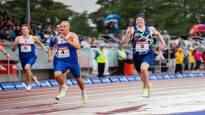Viljami Kaasalainen ran to victory in the Jyväskylä GP competition with 400 meters. In the competition, a total of three Finns reached their record and at the same time for the first time under 47 seconds.
The athletics Kaleva competitions will be shown on channels from August 4th to 7th. and the European Championship 15.–21.8.
At the Jyväskylä GP, particularly good 400m times were recorded for Finns on Tuesday. Especially when you look at the statistics in the 21st century. In the competition, no less than three Finnish athletes broke under 47 seconds.
Those who ran to victory reached their new records with a time of 46.54 Viljami Kaasalainenthe runner-up in the competition with a time of 46.80 Samuel Purola and third in the competition with a time of 46.92 Eljas Aalto. At the Jyväskylä run, Kaasalainen rose to eighth place in Finland’s all-time statistics.
A run like Tuesday’s has been in the sights of the athletics coach and ‘s expert Mikeal Ylöstalo along for a long time. In Jyväskylä, the weather conditions also hit the spot. Kaasalainen’s coach Antti Mero described Tuesday’s competition as excellent overall.
– The rain didn’t bother me at all and the wind was very small and it was favorable on the back straight, which is an advantage in a 400-meter run, Mero said.
Kaasa’s spring training went excellently. After the successful camps, the runner and the coach expected hard results for the first races. At the beginning of the season, headwinds and lack of relaxation were still an obstacle for Kaasalainen.
– A certain number of races are required to maximize the score. In addition, a lightened rest period is still required, which Viljam succeeded in this as well, Mero says about the Jyväskylä run.
Hard times behind
As a competition format, the 400-meter running distance has experienced a major change. Even in the 70s and 80s, the trip was very popular. Current Markku Kukkoahon Finland’s record time of 45.49 is 50 years ago.
– In the men’s 400-meter run, the level has been almost miserable in the past decades, Mero describes.
It is also interesting that the 400 meters race in Jyväskylä was the third ever in Finland, where three athletes have reached a result of less than 47 seconds. The two previous competitions are from 1984 and 1988.
Behind the difficult times of 400 meters is the popularity of shorter running distances, when by Carl Lewis and Usain Bolt’s stars like have shown the way on fast trips.
– There has been an upward trend in sprinting for several years, and now it is starting to spread to the quad, says Ylöstalo.
However, the journey of the whole round is interesting, because you can reach it from short distances such as 800 meters. The domestic top names of the season have come to the trip from the side of hard speed training and short distances, says Ylöstalo.
In addition to Aalto, Kaasalainen and Purola, among others Konsta Alatupa100-meter Finnish champion from 2019, and currently competing in 800 meters Eveliina Määttänen have moved from sprinting towards longer competitive distances.
Behind the change of approach
According to Ylöstalo, Finns’ 400m results have started to improve through the accumulated speed characteristics. At the same time, Ylöstalo ponders whether the approach to 400 meters has previously been too focused on endurance.
Compared to previous years, even better 200-meter runners have been found among domestic runners, which means that fast athletes have also been found for the 400-meter distance. According to Mero and Ylöstalo, speed is also a decisive factor in the 400-meter distance.
– The tough exercises that are part of endurance running have taken a backseat. They make you tired, but at the same time eat away at speed, Ylöstalo describes.
For example, Purola runs 400 meter races through pure speed. He has done quantitatively few exercises that would improve the time of an entire track lap. However, Ylöstalo also sees great potential in Purola for the 400-meter run.
In Jyväskylä’s record-breaking run, Kaasalainen’s speed distribution was spot on. It included good acceleration and relaxation, so that the run remained up until the finish line. The speed and power characteristics are in good condition in the Kaasalan. In the runner’s training, the finalization of maximal oxygen uptake and speed endurance is in progress.
According to Mero, Kaasalainen’s peak season can be expected in the next two seasons. Improving endurance characteristics must be done carefully, so that speed characteristics suffer. The rule of thumb of Kaasalainen and Mero, who have been working together since spring 2020, has been to improve the record by one second per season.
– Now let’s see how many years will pass with that principle, Mero states.
